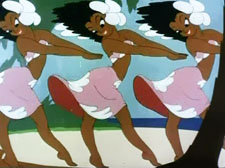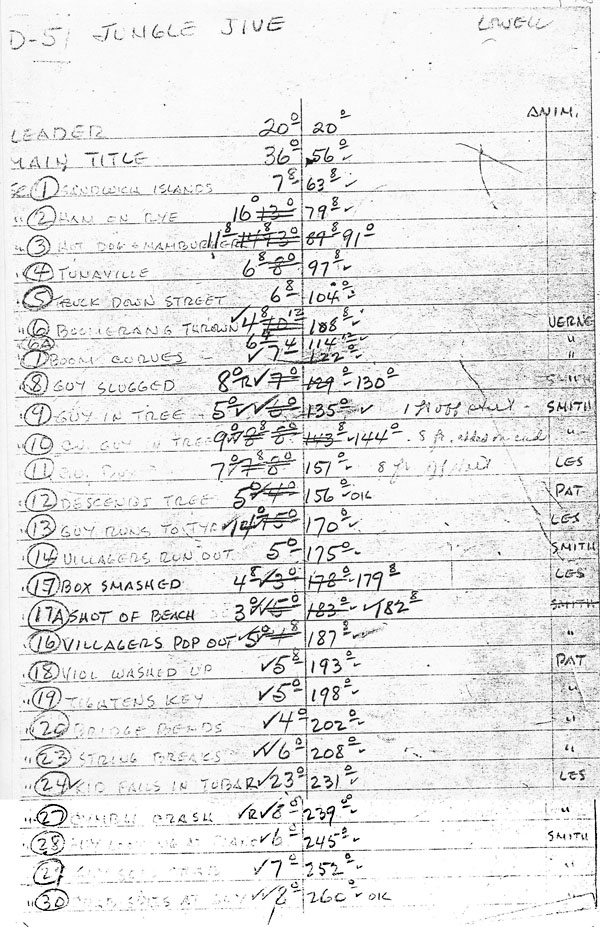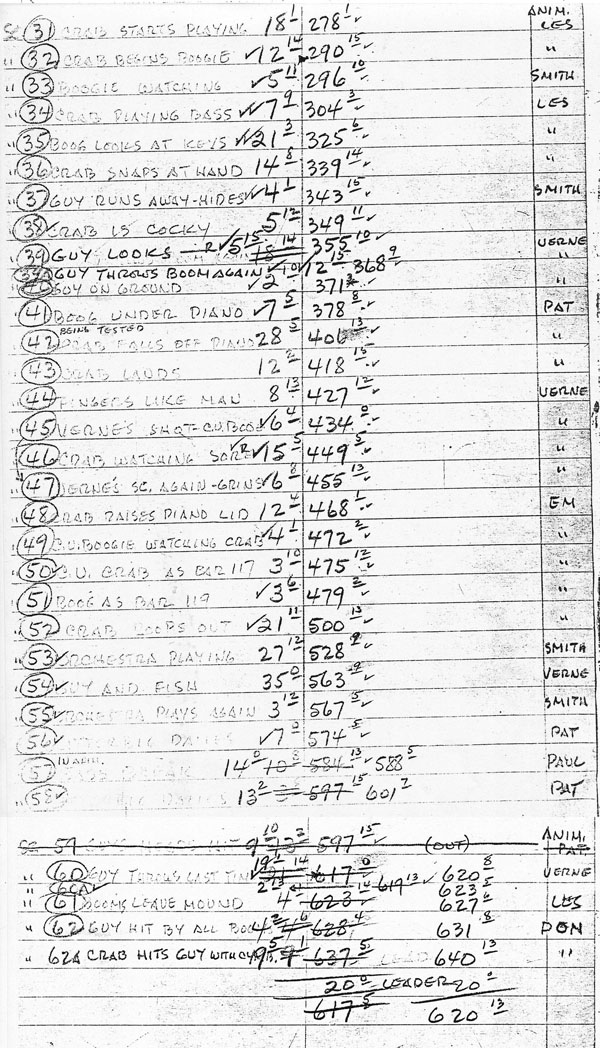
Time for some boogie-woogie jungle rhythm!
During his directorial stint at Lantz, Shamus Culhane often clashed with storyman Ben “Bugs” Hardaway. Culhane’s high standards in artistic education and Hardaway’s earthy, Mid-Western background made their methods of shaping animated films like night and day. Though the writing served its comic purposes, Hardaway’s abilities as a gagman impaired them. Culhane recollected his dismissive attitude towards suitable plotting and characterization. Hardaway felt that such necessities were “too scientific and technical.” To him, any gag worked, regardless of whether it advanced the story or not.
Jungle Jive opens with footage dedicated to sign gags related to the Sandwich Islands – a Hardaway trademark. Culhane wrote in Talking Animals and Other People: “During a production meeting, as he read the puns off the storyboard during a presentation, ’Bugs’ would laugh until the tears rolled down his cheeks.” Culhane would discern which puns to excise and augment the storyboard with his own gags, much to Hardaway’s chagrin. Static puns were cost-effective for the Lantz studio’s lower budgets, so the director often had to succumb to the lesser material.
The clash between Culhane and Hardaway extended further into the production of this cartoon. Jungle Jive is noteworthy for containing the last recorded performance by jazz pianist Bob Zurke. In his memoir, Culhane recollected Hardaway’s disapproval over the boogie-woogie music. Evidently, during the recording, he stated, “There’s too many damn places where the music stops.” After a lengthy argument with musical director Darrell Calker and Zurke, the frustrated writer rejoined Culhane and Lantz in the recording booth. As Shamus remembers, Hardaway spoke: “That sum-bitch can’t even read no music, an’ he says that he already forgot what he just now played. What the hell did Calker git in a dumb guy like that for?” Zurke’s performance, used for the arrogant crab scuttling along the piano keys, serves as the highlight of the cartoon.The animation in most of this cartoon isn’t particularly striking. The majority of it is assigned to Les Kline and Paul Smith. Their animation is straightforward, without the strengths that the other animators demonstrate in this cartoon. Pat Matthews’ scene 18 adds a nice touch, when the curious native quickly recoils his hand away from the tuning peg. Scene 42, with the crab on the piano, showcases a Matthews earmark: he often animated a character’s surprised reaction by popping from one pose to another, without in-betweens. Emery Hawkins’ animation of the crab exerting himself to exhaustion in scene 52 (with some neat dry-brush smears) is wonderfully timed to the music.
It’s fascinating to see Don Williams’ animation in the last two shots of the cartoon, since he wasn’t given any other footage. Scene 62, with the native tumbling and crashing through the instruments, has brilliant drawings and subtle nuances that can only be appreciated if the viewer freeze-frames them. Since the scene plays very quickly, here’s a clip of this sequence, slowed down for you to see:
As with the other Lantz documents, some scene numbers are missing from the draft. Different shots listed are re-shuffled; for instance, shot 17 occurs after shot 11 in the cartoon. In the draft, it indicates that the native lookout alerts the villagers before the box, carrying musical instruments, crashes onto the shore. Scene 38 is missing an animator credit, but judging from the drawing/timing of the crab, the animation is attributed to Emery Hawkins. (Likewise for shot 60A, now attributed to Paul Smith.) Shot 54 in the draft implies a fish was originally involved, replaced with an alligator later on.
 Besides Hardaway’s sign gags being used as “footage eaters,” other cost-cutting measures used in Jungle Jive. Shot 17A, originally intended for Paul Smith, is instead a static shot. Since it cuts right to the curious native observing a violin, Smith presumably might’ve been assigned to animate the villagers eagerly dashing up to the instruments. There are many instances of re-used animation near the end of the cartoon — the boomerang tossing native (scs. 6 and 60), the boogie-woogie native playing the piano (scs. 45 and 47; 49 and 52), the orchestra (scs. 53 and 55) and the “jitterbug dames” seen in the opening titles (scs. 56 and 58).
Besides Hardaway’s sign gags being used as “footage eaters,” other cost-cutting measures used in Jungle Jive. Shot 17A, originally intended for Paul Smith, is instead a static shot. Since it cuts right to the curious native observing a violin, Smith presumably might’ve been assigned to animate the villagers eagerly dashing up to the instruments. There are many instances of re-used animation near the end of the cartoon — the boomerang tossing native (scs. 6 and 60), the boogie-woogie native playing the piano (scs. 45 and 47; 49 and 52), the orchestra (scs. 53 and 55) and the “jitterbug dames” seen in the opening titles (scs. 56 and 58).
Enjoy this week’s breakdown video! I won’t have a breakdown for next week – there are personal matters that need sorted out at the moment. Plus, I wouldn’t want to burn out, after all. I will be back the following week — so don’t despair.
NOTE: The light writing on the draft below makes a few scene descriptions hard to read, so I’ve listed the more faded ones here:
Sc. 11: “C.U. Box”
Sc. 28: “Boy looking at piano”
Sc. 29: “Boy sees crab”
Sc. 30: “Crab spits at boy”
Sc. 55: “Orchestra plays again”
Sc. 56: “Jitterbug dames”
Sc. 57: “Bass break”
Sc. 58: “Jitterbug dames”


(Thanks to Mark Kausler for his help.)



 DEVON BAXTER is a film restoration artist, video editor, and animation researcher/writer currently residing in Pennsylvania. He also hosts a
DEVON BAXTER is a film restoration artist, video editor, and animation researcher/writer currently residing in Pennsylvania. He also hosts a 




















































































Love this cartoon! One of more unusual scenes was when one of the islanders got his head stuck in a tuba and started growling and muttering in a “Let Me Outta Here!!” way and islander #2 came by and blew into the mouthpiece causing the tuba to uncurl and making a “moooo” like sound that came out of the tuba!
Thanx for this’un Devon! Haven’t seen JJ in decades.
I loves me some Swing Symphonies. I wish someone would compile and distribute all of Lantz’s musical titles.
Culhane’s bio also mentions the pride he took in his work animating the crab to the music and sound effects for “Hawaiian Holiday” while at Disney. The bit here seems to be something of an attempt to recreate that, while the Lantz studio had used a gag just prior to Shamus’ arrival that featured a dancing spider on a piano in “$21 a Day (Once A Month)” which Hardaway worked on as writer. So the crab-on-the-keyboard here could have come from either direction, and might actually represent a successful gag collaboration between the two.
Boy, do I wish that Harman/Ising’s famed (or imfamous) BOSKO trilogy were this good. Oh I like the Hugh Harman cartoons quite a bit, but what needed to be focused upon in humorous visual ways is the music. I wanted to feel the jazz groove in those cartoons a lot, with the hot jazz rhythmns bringing on the more wild gags in montage toward the end! Stuff like this was also what made me wish for a third volume of WOODY WOODPECKER AND FRIENDS featuring more of the one shot titles and slightly less Woody.
Thanks for this… always an awesome cartoon, regardless of if I’m enjoying it on TV at 7 yrs old or seeing it on the web now that I’m 51. 🙂 I love the way Laverne Harding works those rolls of fat at 4:31.
Lantz really had a stellar crew in the mid-40s…Hawkins, Matthews, Harding, Williams… such great-looking animation!!
Hated this cartoon. Every damn signifier of the sort of casual dismissal of any culture that’s not Euro-American is front-loaded and in your face. Are these natives Africans, Polynesians, indigenous Aussies – oh who cares, just make them childlike and throw in a a lot of ooga-booga stuff – say a big round stewpot and a gag involving those crazy neck rings you saw in National Geographic once. Top it off with an implied insult, say that a jumping crab invented jazz, because who’d believe a bunch of primitive pagans had it in them?
The Lantz studio did several like this, but then so did every studio. I know we’re supposed to dismiss it all with a shrug and some disclaimer that “those were different times, we must separate the artistry from the prevailing racial attitudes of the period”, and such. I refuse to believe the creators of this cartoon didn’t know how offensive some of this stuff could be to some audience members. I fear they thought they could get away with a lot worse than what you’d see in a live short, because it was a cartoon. Having watched many of appalling old cartoons lately (this is hardly the worst), often labeled something like “BANNED! RACIST ANIMATION!” on YouTube (how naughty!), I’d have to say that pound-for-pound American cartoons from the teens through the fifties had a higher quotient of this sort of vileness than, say, live action comedies. Shame.
You forgot to mention sex-objetified women.
Dear, Mr Mork:
Who Cares?
A lot of us do
Agree completely
Had not seen this in a while but while reviewing it totally agree
It’s very interesting that most old cartoons with jazz music depict racist images and though I understand the historical content I feel if they are going to be shown that info should be given regarding the images shown or not show it at all (i.e Song of the South)
Dear Peter Mork:
Amen!!!
Bob Zurke was a classically trained child prodigy who played before Paderewski at age 5 and joined the NBC Orchestra at age 15, so he was hardly a “dumb …. sumbitch who can’t even read no music” in the words of Bugs Hardaway. In fact he was considered one of the best boogie-woogie pianists who could also read, maybe the best who had both musical educatiion and true boogie feel and chops. Read “A Left Hand Like God” by Peter J. Silvester for great information on Boogie Woogie.